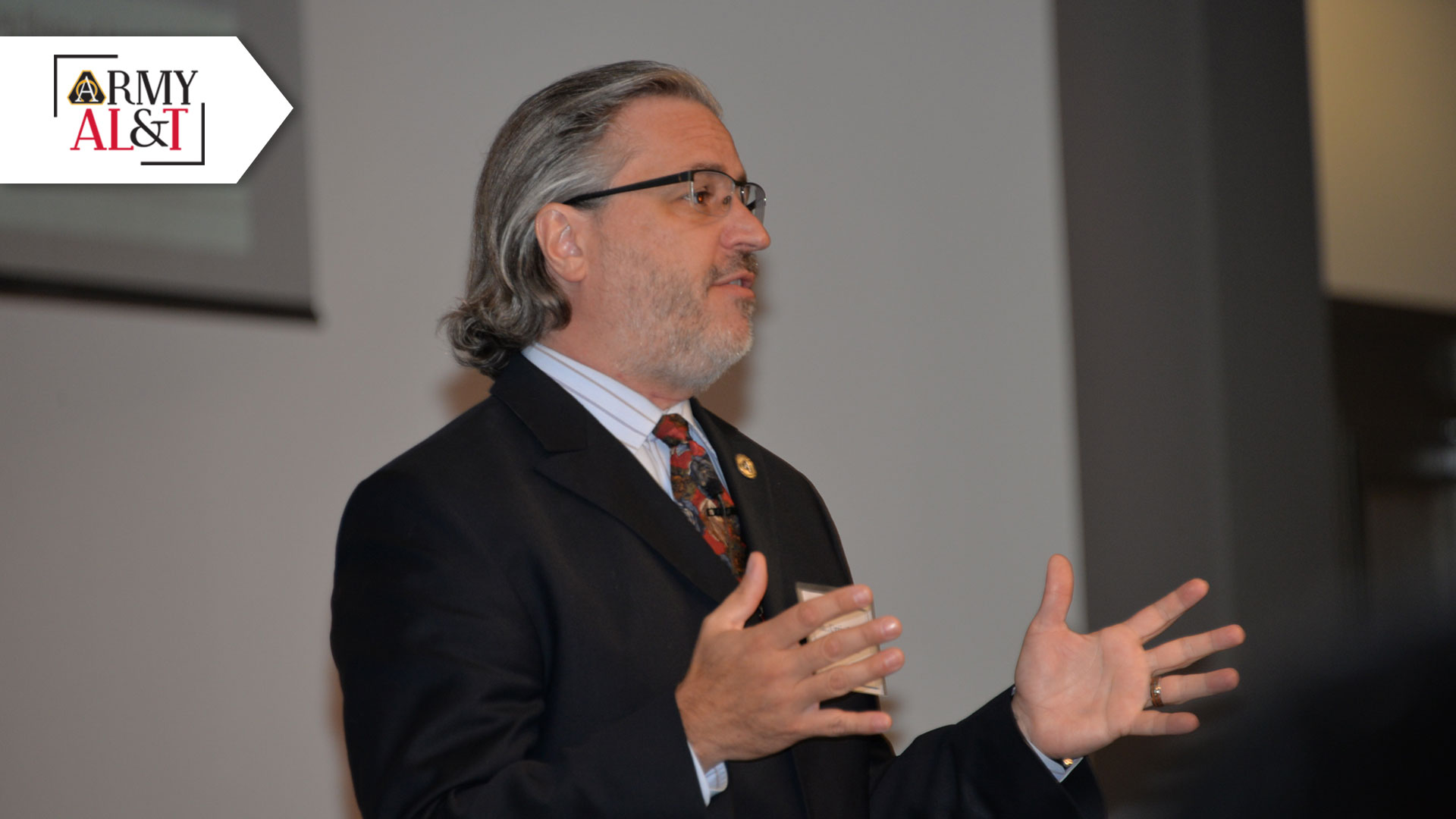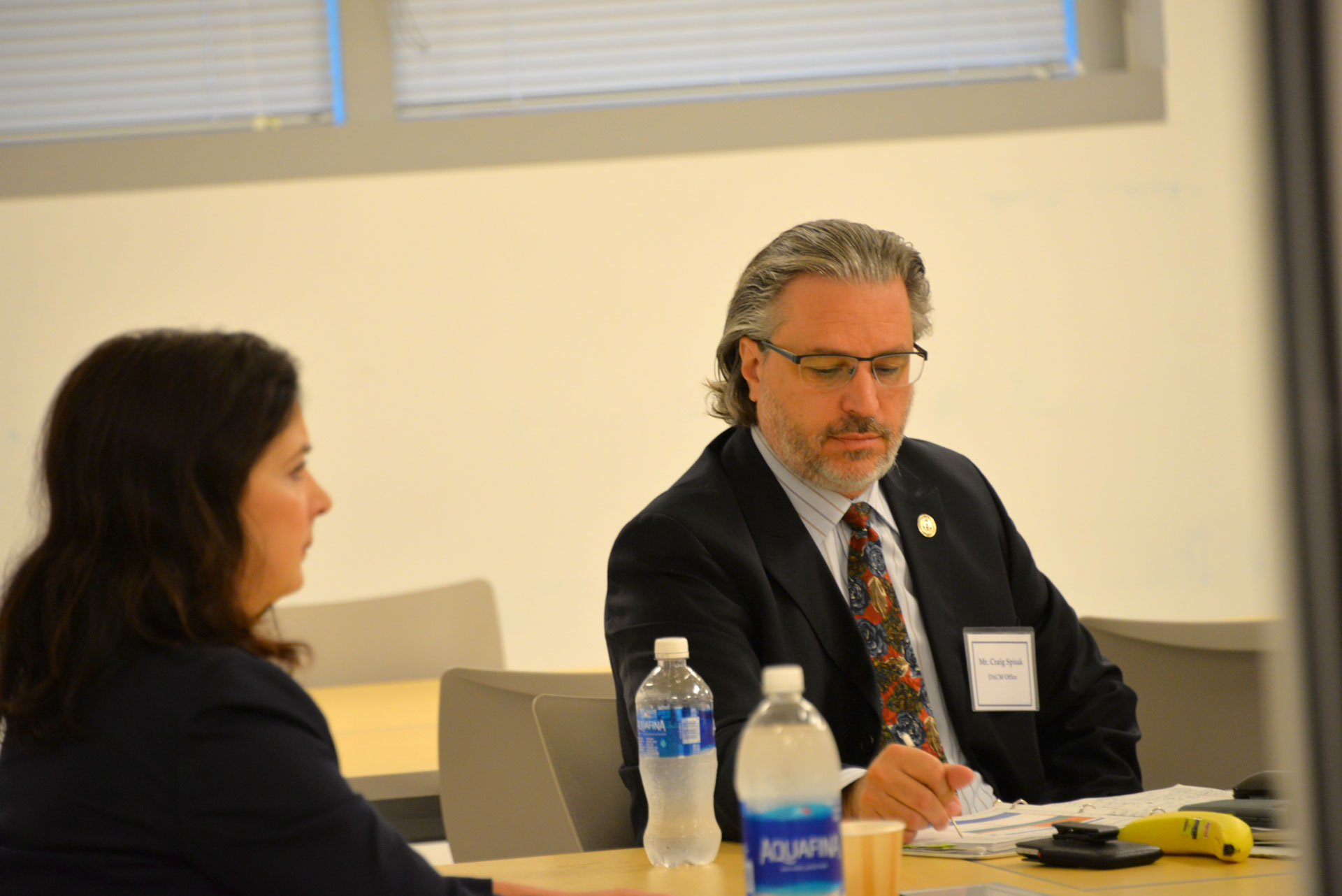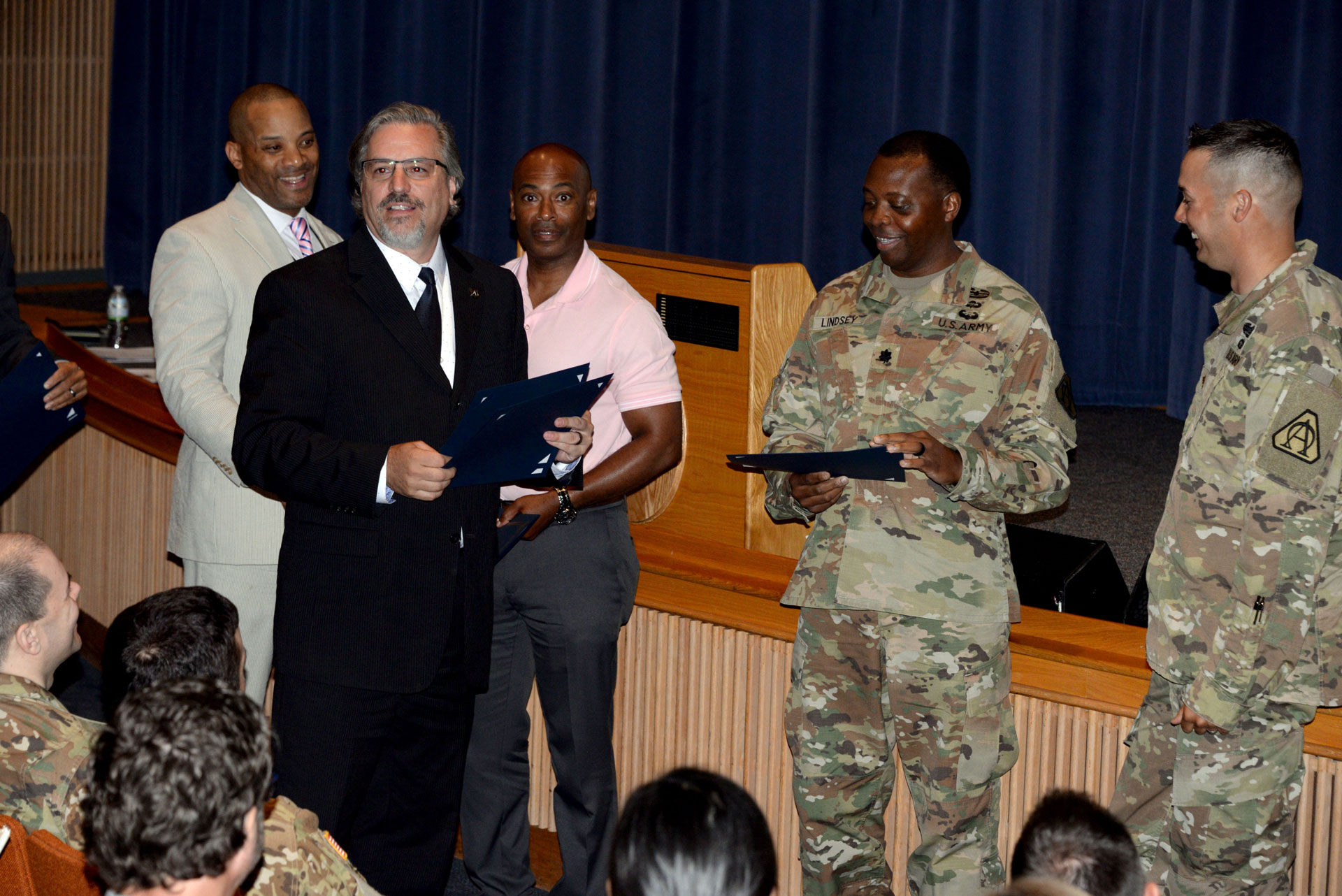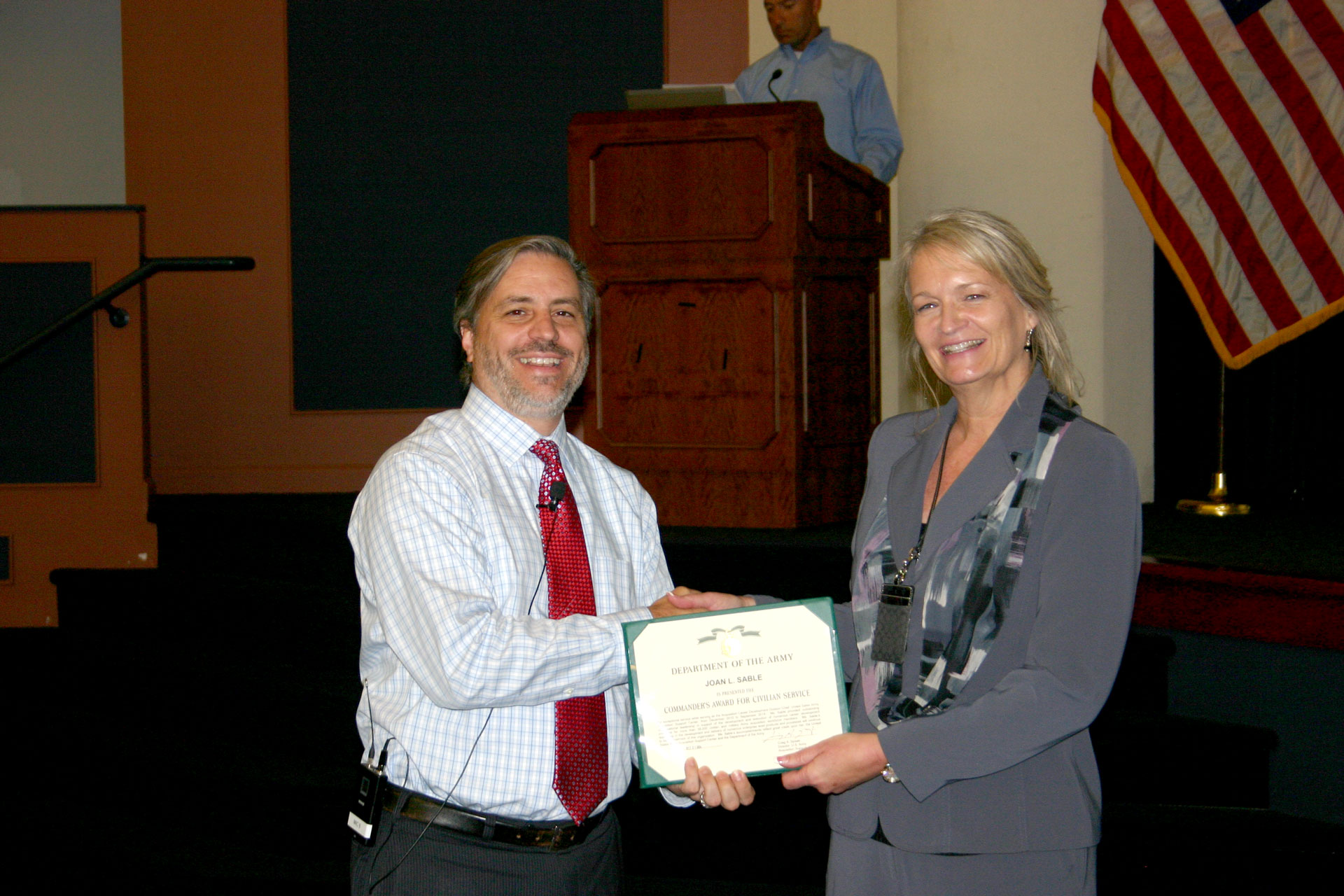
REMARKABLE SERVICE: Spisak delivered comments to members of the Army Acquisition Workforce (AAW) at the AAW Summit in September 2017.
Craig Spisak may be retiring, but his legacy at USAASC will live on.
by Margaret C. Roth
If you look at the myriad opportunities for professional growth that the U.S. Army Acquisition Support Center (USAASC) offers to the acquisition workforce, only two predate the tenure of Craig Spisak as USAASC director: tuition assistance and the Competitive Development Group, of which Spisak was a member of the original (1997) cohort. That’s the size stamp Spisak leaves on USAASC as he prepares to retire at the end of July.
Spisak “has turned many of the [principal military deputy’s] great ideas into reality,” said Lt. Gen. Robert L. Marion, principal military deputy (PMILDEP) to the assistant secretary of the Army for acquisition, logistics and technology (ASA(ALT)). Marion listed as examples the creation of civilian product director positions, enhanced command preparation, and development of new curriculum at the Naval Postgraduate School. In the ASA(ALT) hierarchy, the PMILDEP is the primary point of contact for USAASC’s director, since both have specific responsibility for managing acquisition careers.
Dr. Bruce D. Jette, the ASA(ALT) from January 2018 to January 2021, relied heavily on Spisak to execute his ideas for officer development. One of Jette’s top priorities was to put together a program management career path to a master’s or doctorate in the sciences; acquisition programs have relied too much on readily available business expertise, when some sorely need scientific leadership. Lt. Gen. Paul A. Ostrowski, the PMILDEP at the time, was instrumental in developing the program, which Marion now spearheads. “None of that gets done without Craig’s personal involvement,” Jette said.
It’s important to remember that, as Jette put it, the director of acquisition career management (DACM) “really doesn’t own everything,” meaning that the personnel management actions Spisak generated required the approval of U.S. Army Resources Command and various selection boards, whose members may or may not appreciate the particular needs and requirements of an acquisition officer. “He’s done a great deal to try to keep all of that in play and balanced,” Jette said. “He’s a smart guy, he understands the environment and the people. And he goes and makes stuff happen.”
“Everything we’re doing today—Senior Service College Fellowship, Human Capital Strategic Plan, Naval Postgraduate School curriculum, Inspiring and Developing Excellence in Acquisition Leaders—these are all efforts that have been birthed during his tenure,” said Brian Winters, chief of proponency and analysis at USAASC. “Even with the existing programs in his tenure, he’s been a part of making them better aligned to acquisition objectives and keeping them current as the workforce changes, as a mission changes.”
How did Spisak accomplish so much?
With a talented, highly motivated team, a focus on the mission and a style uniquely his own.

TAKE NOTE: Spisak was focused at the 2017 Army Acquisition Workforce summit.
TAKE THE MISSION AND RUN
An engineer by training, Spisak has an instinct for taking things apart that left many in awe, and a memory that instilled caution in those who worked with him.
“He can walk into any room, understand the atmospherics in a room, understand who is in a room, and has the [sense] to be able to explain or articulate a position on any given matter in a coherent, clean and easy-to-understand way,” said Ostrowski. “Craig literally knew everything there was with respect to things that we asked him to do—the roles that we asked him to play, and the mission sets that we provided.”
When asked, Spisak invariably said yes, Ostrowski said. “Craig is the kind of person that would never turn down a challenge or an opportunity. No matter what we asked him to do, whether it was in his lane or not, he offered solutions that got to yes.”
With mission in hand, Spisak delegated the execution to members of the staff, said Tom Evans, former Workforce Management Division chief, who first came to USAASC in 2000. “He’d give you a mission, and he normally would not go to any lengths to micromanage you, unless he thought you needed it. If I needed guidance, I could walk into his office and get it. Otherwise, he’d let me run my organization the way I wanted to and supported me when I needed it.”
“You can’t be everyplace all the time. And if you’re doing their jobs, it’s impossible for you to do yours, and Craig understood that very early. A lot of people don’t learn that skill.”
Spisak put himself in a position to absorb the turbulence of the Pentagon airspace in the course of providing support to nine ASA(ALT)s. “It is very difficult to go through the transitions of those commands and hierarchy, and he protected us,” Evans said. “Craig acted as a filter from what I call the ‘good idea fairies.’ He had the ability to limit, and understood how to deal with higher leadership to explain the possibilities of success and failure.”
BUILDING ACQUISITION PROFESSIONALS
Spisak took pains to look after the personal and career goals, wants and needs of USAASC staff members—an aspect of leadership that was invaluable to those who benefitted from it.
“When he says if you want some career advice come see him, not enough people do it,” said Scott Greene, chief of the Strategy and Communications Division at USAASC.
Greene took advantage of Spisak’s open door to review his career path with Spisak once a year or so. It was time well spent, he said. “Trusting in me, believing in me, developing me—really making that a point of, you know, supporting anything I wanted to do to build myself—really empowered me,” he said. “He would give you that honest feedback [on] strengths and areas to improve on, and I always found good value in that.”
Over time, the relationship opened opportunities for Greene to be Spisak’s right-hand man on major initiatives such as the establishment of a new acquisition curriculum at the Naval Postgraduate School, which meant traveling to Monterey, California, with Spisak. “That was really great, you know, personally and professionally. Getting to engage with the students out there was very cool,” as was meeting a lot of military senior leaders there.
The experience showed Greene a different side of Spisak than the leader USAASC was accustomed to seeing at all-hands meetings or giving a presentation. “He really is a genuinely fun, good, nice guy that really does care about his people,” Greene said. “He’s very in tune with his emotions. He’s actually a very sensitive guy, [and] he valued all of his employees.”
Spisak often said he made a practice of surrounding himself with people smarter than him. “I don’t think that’s the case, because he is very smart. But he does want to surround himself [with] people who are passionate and know what they’re doing,” said Greene.
“He has to ensure that his staff is incredibly responsive. And I think we’ve done a great job in helping him with that. He allows us to bring him visions of, ‘Hey, here’s where we think we should go.’ And then he enhances them.”

HUMOROUS APPROACH: Spisak shared a laugh with teammates will presenting certificates to members of the workforce during a USAASC all-hands meeting June 18, 2018.
TOTAL RECALL
To brief an issue for Spisak was to step into a challenging world with a master of information and delivery.
“His recall capability was just off the charts,” said Evans, who cautioned his staff that what they briefed to Spisak “had better be right, because he’ll remember exactly what you said to him.”
Another gift Spisak brought to his briefings was that “he could talk to anyone, anytime,” said Joan Sable, former deputy director of acquisition career management. ”He was so good on his feet. He could wrap up [an issue] in a pretty bow, and it would be very succinct and very informed. And he had all the knowledge. There were times … he would surprise me and have it all figured out.”
Both Evans and Sable looked back on their sometimes contentious exchanges with Spisak with an ironic chuckle. “You know, everything wasn’t agreed. We used to have some interesting discussions,” Evans said. “But I never felt he didn’t listen to my argument. He may not agree with it, but he at least listened.
“You had to be convinced that what you were doing was right. And then he listened. He expected you to know your job.”
Sable had a similar experience. “I definitely had challenges working with him, for him. But he definitely supported us. You had to have your ducks in a row, you know, or else he’d kind of shoot it down and you never got past go.”
In policy discussions, “He wasn’t afraid to challenge you,” said retired Lt. Gen. N. Ross Thompson, who served as PMILDEP from September 2006 to February 2010. “If he would come in with something and you’d push and push and push and say, ‘I’d like to do it this way,’ he’d give you the reasons why maybe that wasn’t such a good idea. But in the end, you know, we always came up with what we thought was the best course of action, and that wasn’t my way or his way, it was the collective back and forth.”
LASTING LEGACY
Spisak’s commitment to finding the best data and technology to support USAASC’s work put the organization in the acquisition spotlight. “All the other services would look at the Army and say, ‘Wow, you’ve got a system where you can pull up information and look at people’s profiles over the years, you can look at the training over the years.’ A lot of the services tried to replicate what we were doing,” said Sable.
It was gratifying to see, she said. “Craig and I would attend DOD-level meetings with the acquisition leadership. And there we got a lot of kudos for having everything automated very early on. We had a one-page record brief that mirrored what the Army officer record brief looks like and the enlisted record brief. That was huge.”
Sable credits Spisak for bringing that to fruition. “That enabled us to be a better office for the acquisition workforce. Because we could pull up all kinds of information, and then we could do analysis of the data to determine the path forward: Where we are now? Where do we need to go?”
That’s how the Human Capital Strategic Plan came about, Sable said: “Let’s try to have a five-year plan that gives us some direction on what to do for the workforce. Do they need to be more educated? Do we need more diversity? There’s just all kinds of things, and we were able to have all that data at our fingertips when we went to those high-level meetings. And we’ve really made a name for ourselves. And I believe Craig was the one responsible for making that happen.”
Another USAASC initiative that got the attention of DOD-level leadership and recognition from across DOD was legislation, incorporated in the National Defense Authorization Act, to improve the acquisition workforce. “So we participated in human capital forums to identify the challenges and how can we legislatively address one,” Sable said, who provided assistance in writing it. The result was a body of legislation addressing, among other things, recruiting and hiring. “We had expedited hiring authority and direct hiring authority to bring on the kind of talent we needed in the workforce. We were at the cutting edge.”

A VERSATILE LEADER: Joan Sable received the Commanders Award for Civilian Service at the October 2014 USAASC all-hands meeting. Of Spisak, she said “He could talk to anyone, anytime.”
WORK-LIFE BALANCE
Spisak also saw a need to lead management practices in the area of balancing work and home lives.
Way before the COVID-19 pandemic forced most employees to telework in both the public and private sectors, Spisak was willing to provide USAASC staff members flexibility in their hours to accommodate situations at home that required their attention.
His openness allowed Kelly Terry to put her daughter’s medical needs first from the time she was diagnosed with cancer in 2007, through a period of remission, to her passing in 2013.
“The organization was so incredibly accommodating to me,” said Terry, then a USAASC regional director based at Picatinny Arsenal, New Jersey.
“I literally walked into work one day, I got the call from her daycare [that she was sick] and didn’t come back for seven months,” said Terry. Spisak, Terry’s supervisors and colleagues “worked together to ensure the mission didn’t become impeded.”
“The way they treated me, checked in on me, checked in on my family, was amazing. And they were very cognizant of the fact that even [when] she had no evidence of disease, we still were getting treatment,” which required out-of-state travel.
“[Spisak] and his senior leadership allowed me the flexibilities to focus on my daughter and my son,” she said.
“I am forever grateful for his leadership style. And the folks that he selects to be under him sharing, you know, that same thing, that mission is just one piece of who we are. And if we work together, we can still get it all done, no matter what’s going on. He understood the importance of taking care of people.”
LOOKING FORWARD
What happens when Spisak has cleared out his office and his day-to-day priorities center not on the care and development of the organization and its individual members’ needs and responsibilities, but on what he’s going to accomplish first around the house? That remains to be seen, but one thing is certain—whether he’s focused on hobbies, home improvement projects, or anything else, he will be sorely missed at USAASC.
Spisak “is the glue, quite frankly, that held that organization together,” Ostrowski said. “And he walks away with a ton of experience. And he knows roles [and where] skeletons are buried. He’s been there a long time, and he will be absolutely missed. Because you can’t replace that experience overnight.[There’s] just no way.”
MARGARET C. ROTH is an editor of Army AL&T magazine. She has more than a decade of experience in writing about the Army and more than three decades’ experience in journalism and public relations. Roth is a MG Keith L. Ware Public Affairs Award winner and a co-author of the book “Operation Just Cause: The Storming of Panama.” She holds a B.A. in Russian language and linguistics from the University of Virginia.


